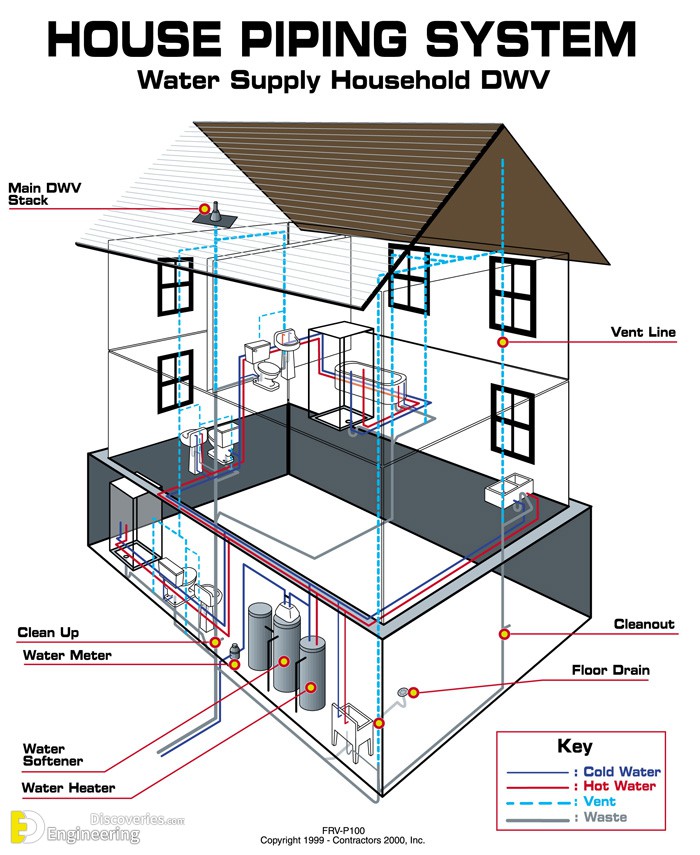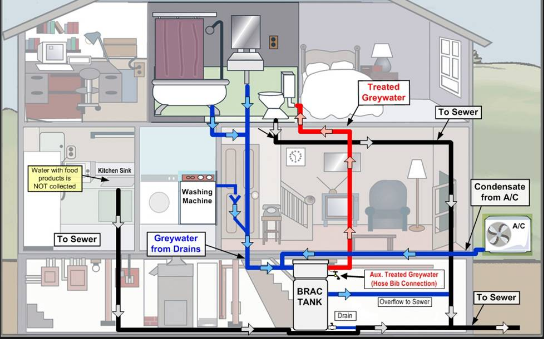The Main Elements of Your House's Plumbing System
The Main Elements of Your House's Plumbing System
Blog Article
How do you feel in relation to Plumbing Installation 101: All You Need to Know?

Comprehending how your home's plumbing system functions is necessary for every homeowner. From providing tidy water for alcohol consumption, food preparation, and bathing to securely eliminating wastewater, a well-kept pipes system is vital for your household's health and wellness and convenience. In this comprehensive overview, we'll check out the intricate network that composes your home's pipes and deal ideas on upkeep, upgrades, and taking care of typical concerns.
Introduction
Your home's pipes system is more than just a network of pipelines; it's a complex system that guarantees you have access to tidy water and efficient wastewater elimination. Knowing its parts and exactly how they interact can assist you prevent expensive fixings and make certain whatever runs efficiently.
Basic Elements of a Plumbing System
Pipelines and Tubing
At the heart of your pipes system are the pipes and tubes that carry water throughout your home. These can be constructed from different products such as copper, PVC, or PEX, each with its benefits in terms of longevity and cost-effectiveness.
Components: Sinks, Toilets, Showers, and so on.
Fixtures like sinks, commodes, showers, and bath tubs are where water is used in your house. Understanding just how these components connect to the pipes system helps in identifying troubles and planning upgrades.
Valves and Shut-off Points
Shutoffs regulate the flow of water in your plumbing system. Shut-off shutoffs are critical during emergency situations or when you require to make repairs, enabling you to isolate parts of the system without interrupting water circulation to the entire residence.
Supply Of Water System
Main Water Line
The major water line connects your home to the metropolitan supply of water or a personal well. It's where water enters your home and is dispersed to various components.
Water Meter and Stress Regulatory Authority
The water meter steps your water use, while a pressure regulator ensures that water moves at a secure pressure throughout your home's plumbing system, protecting against damage to pipelines and components.
Cold Water vs. Hot Water Lines
Recognizing the distinction in between cold water lines, which supply water straight from the major, and hot water lines, which lug warmed water from the water heater, aids in fixing and preparing for upgrades.
Drain System
Drain Pipes Water Lines and Traps
Drain pipelines bring wastewater away from sinks, showers, and commodes to the sewer or septic system. Catches prevent sewer gases from entering your home and also catch debris that can trigger obstructions.
Air flow Pipes
Air flow pipes permit air into the drainage system, protecting against suction that can slow down drainage and trigger traps to vacant. Proper air flow is important for keeping the integrity of your plumbing system.
Relevance of Appropriate Drain
Making certain proper drain stops back-ups and water damage. Consistently cleansing drains pipes and preserving catches can protect against expensive fixings and extend the life of your plumbing system.
Water Heater
Types of Hot Water Heater
Water heaters can be tankless or conventional tank-style. Tankless heating systems heat water on demand, while storage tanks save warmed water for immediate usage.
Just How Water Heaters Connect to the Plumbing System
Recognizing how water heaters attach to both the cold water supply and hot water distribution lines assists in detecting issues like inadequate warm water or leakages.
Maintenance Tips for Water Heaters
Frequently purging your hot water heater to remove debris, checking the temperature setups, and evaluating for leaks can expand its lifespan and boost energy effectiveness.
Common Plumbing Concerns
Leaks and Their Reasons
Leaks can happen because of maturing pipes, loose installations, or high water pressure. Attending to leakages promptly avoids water damages and mold growth.
Obstructions and Clogs
Obstructions in drains and toilets are frequently caused by purging non-flushable items or an accumulation of oil and hair. Using drainpipe displays and being mindful of what goes down your drains pipes can stop blockages.
Indicators of Plumbing Troubles to Watch For
Low water pressure, sluggish drains pipes, foul odors, or unusually high water costs are signs of prospective pipes issues that need to be addressed quickly.
Plumbing Maintenance Tips
Regular Inspections and Checks
Schedule yearly pipes inspections to catch concerns early. Look for signs of leakages, corrosion, or mineral buildup in taps and showerheads.
DIY Maintenance Tasks
Easy tasks like cleansing tap aerators, looking for commode leakages making use of color tablet computers, or protecting subjected pipelines in cool environments can protect against significant pipes concerns.
When to Call an Expert Plumbing Technician
Know when a plumbing issue requires professional knowledge. Attempting complicated repairs without proper knowledge can lead to more damages and greater repair work prices.
Upgrading Your Pipes System
Factors for Updating
Updating to water-efficient fixtures or changing old pipes can improve water top quality, decrease water bills, and boost the value of your home.
Modern Pipes Technologies and Their Benefits
Discover innovations like wise leakage detectors, water-saving bathrooms, and energy-efficient hot water heater that can conserve money and minimize environmental influence.
Price Factors To Consider and ROI
Compute the upfront prices versus lasting savings when taking into consideration plumbing upgrades. Numerous upgrades spend for themselves through minimized utility expenses and less repairs.
Ecological Impact and Conservation
Water-Saving Components and Devices
Installing low-flow taps, showerheads, and toilets can considerably reduce water usage without compromising efficiency.
Tips for Decreasing Water Use
Easy routines like repairing leakages without delay, taking shorter showers, and running complete loads of laundry and dishes can conserve water and lower your utility bills.
Eco-Friendly Plumbing Options
Consider sustainable plumbing materials like bamboo for flooring, which is durable and environmentally friendly, or recycled glass for countertops.
Emergency Preparedness
Actions to Take Throughout a Pipes Emergency
Know where your shut-off valves are located and how to switch off the water in case of a ruptured pipe or major leak.
Significance of Having Emergency Contacts Handy
Keep call details for neighborhood plumbings or emergency services readily offered for quick reaction throughout a pipes dilemma.
DIY Emergency Fixes (When Applicable).
Temporary solutions like utilizing duct tape to spot a dripping pipeline or putting a pail under a trickling tap can lessen damage until an expert plumber arrives.
Verdict.
Recognizing the composition of your home's pipes system empowers you to keep it efficiently, conserving money and time on repair work. By complying with normal maintenance routines and remaining notified concerning modern pipes technologies, you can guarantee your plumbing system runs effectively for several years to come.
HOW YOUR PLUMBING SYSTEM WORKS
Which Pipes Do What?
Blue lines = fresh water supply entering the building
Red lines = hot water supply entering the building
Grey lines = pipes carrying waste away from the building and venting pipes carrying gases away from the building (through the roof)
YOUR MAIN PLUMBING SYSTEMS
There are two main plumbing systems that support your home s basic plumbing needs one that brings clean water into your home, and one that sends dirty water away from your home. Connected to the toilet, bath, shower, and other faucets in your home, these two systems keep your water flowing in the right directions.
ACCESSING FRESH WATER
Fresh and clean water is brought into your home through the main water supply line . Filtered through one pipe, this water is pressured to flow into the various fixtures in your home at any given time.
This water can be sourced from a well located on your property, a pond or river (mostly cottages), or, as in most cases, from the city s municipal water treatment centre. However, it is important to note that water that is untreated, such as the water siphoned from ponds or rivers, may not be safe to drink. Personal water supplies always need to be treated for hardness and contaminants before consumed.
MUNICIPAL WATER SUPPLIES
Improve taste and odour
Remove sediment
Eliminate hardness
Reduce chlorine
COLD WATER SUPPLY VS. HOT WATER SUPPLY
Cold water flows into your home or building through the service line, which then distributes hot or cold water to your fixtures. This line is most commonly run through a central column that runs floor to floor. Hot water runs in short and straight pipes as the longer the pipeline, the more heat that will be lost in the transfer. Having shorter pipes also allows residents to access hot water more quickly.
WASTE WATER SYSTEM
Your wastewater system is divided into two parts pipes that send wastewater away from your home and venting pipes that send sewer gas away from your home. Sewage water travels through pipes that flush the water and waste towards local sewers that are operated and managed by your city or town. Most sewer systems rely on gravity to move the wastewater to where it needs to go.
The further away from your toilet or sink, the larger wastewater pipes become. This allows for waste to be disposed of from various parts of your home or business at once without pipe blockages. The angle and flow of these pipes are also essential for keeping your waste pipes clear of build up.
https://harrisplumbing.ca/how-your-home-plumbing-system-works/

HOW YOUR PLUMBING SYSTEM WORKS
Which Pipes Do What?
YOUR MAIN PLUMBING SYSTEMS
There are two main plumbing systems that support your home s basic plumbing needs one that brings clean water into your home, and one that sends dirty water away from your home. Connected to the toilet, bath, shower, and other faucets in your home, these two systems keep your water flowing in the right directions.
ACCESSING FRESH WATER
Fresh and clean water is brought into your home through the main water supply line . Filtered through one pipe, this water is pressured to flow into the various fixtures in your home at any given time.
This water can be sourced from a well located on your property, a pond or river (mostly cottages), or, as in most cases, from the city s municipal water treatment centre. However, it is important to note that water that is untreated, such as the water siphoned from ponds or rivers, may not be safe to drink. Personal water supplies always need to be treated for hardness and contaminants before consumed.
MUNICIPAL WATER SUPPLIES
COLD WATER SUPPLY VS. HOT WATER SUPPLY
Cold water flows into your home or building through the service line, which then distributes hot or cold water to your fixtures. This line is most commonly run through a central column that runs floor to floor. Hot water runs in short and straight pipes as the longer the pipeline, the more heat that will be lost in the transfer. Having shorter pipes also allows residents to access hot water more quickly.
WASTE WATER SYSTEM
Your wastewater system is divided into two parts pipes that send wastewater away from your home and venting pipes that send sewer gas away from your home. Sewage water travels through pipes that flush the water and waste towards local sewers that are operated and managed by your city or town. Most sewer systems rely on gravity to move the wastewater to where it needs to go.
The further away from your toilet or sink, the larger wastewater pipes become. This allows for waste to be disposed of from various parts of your home or business at once without pipe blockages. The angle and flow of these pipes are also essential for keeping your waste pipes clear of build up.
https://harrisplumbing.ca/how-your-home-plumbing-system-works/
We had been introduced to that article on Plumbing Installation 101: All You Need to Know from an acquaintance on a different website. Sharing is good. Helping others is fun. We treasure reading our article about Understanding Your Home's Plumbing Anatomy.
Call Today Report this page